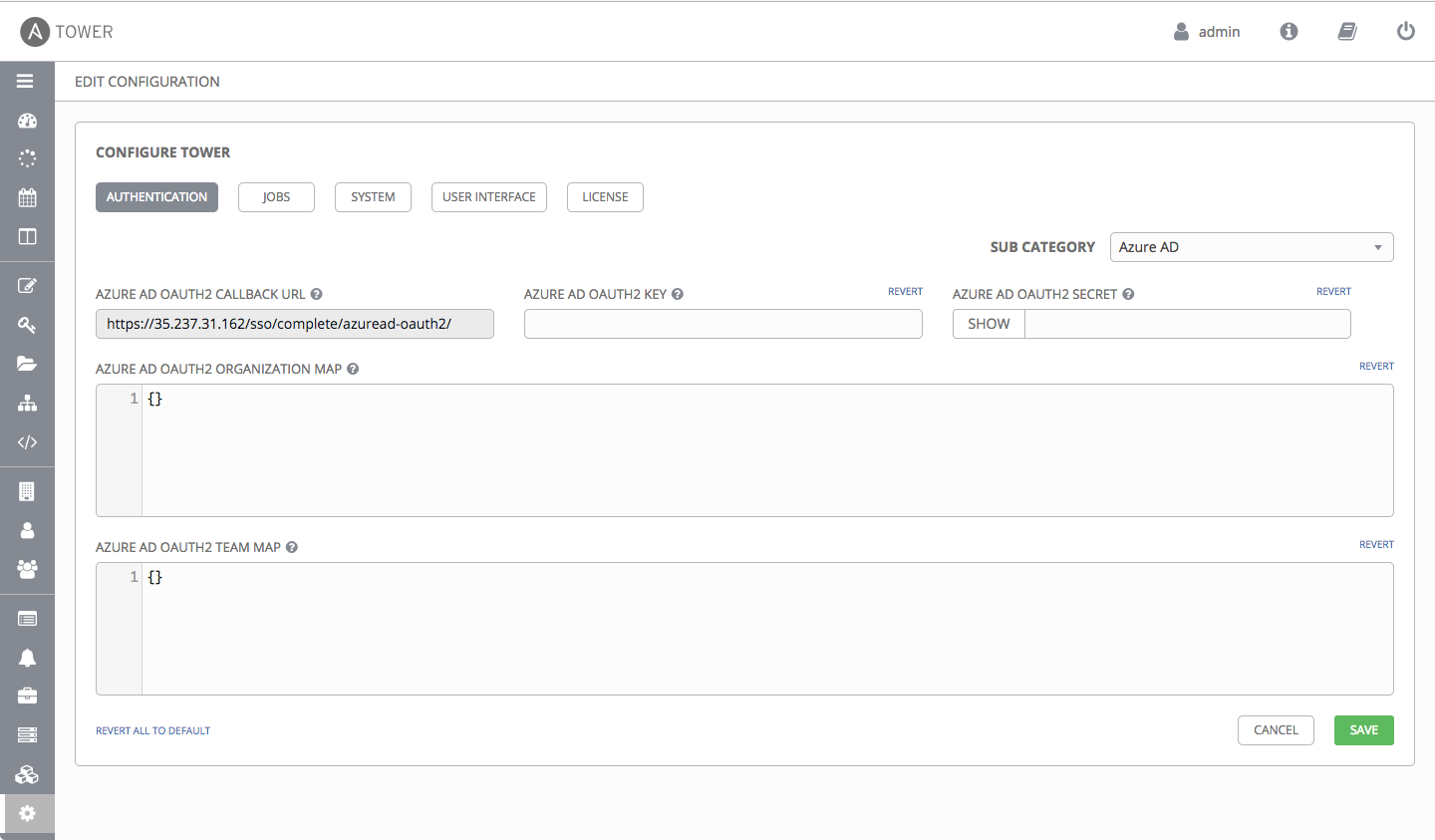5. The Tower User Interface¶
The Tower User Interface offers a friendly graphical framework for your IT orchestration needs. The left navigation bar provides quick access to resources, such as Projects, Inventories, Job Templates, and Jobs.
Across the top-right side of the interface, you can access your user profile, the About page, view related documentation, and log out. Right below these options, you can view the activity stream for that user by clicking on the Activity Stream  button.
button.

5.1. Activity Streams¶
Most screens in Tower have an Activity Stream ( ) button. Clicking this brings up the
Activity Stream for this object.
) button. Clicking this brings up the
Activity Stream for this object.
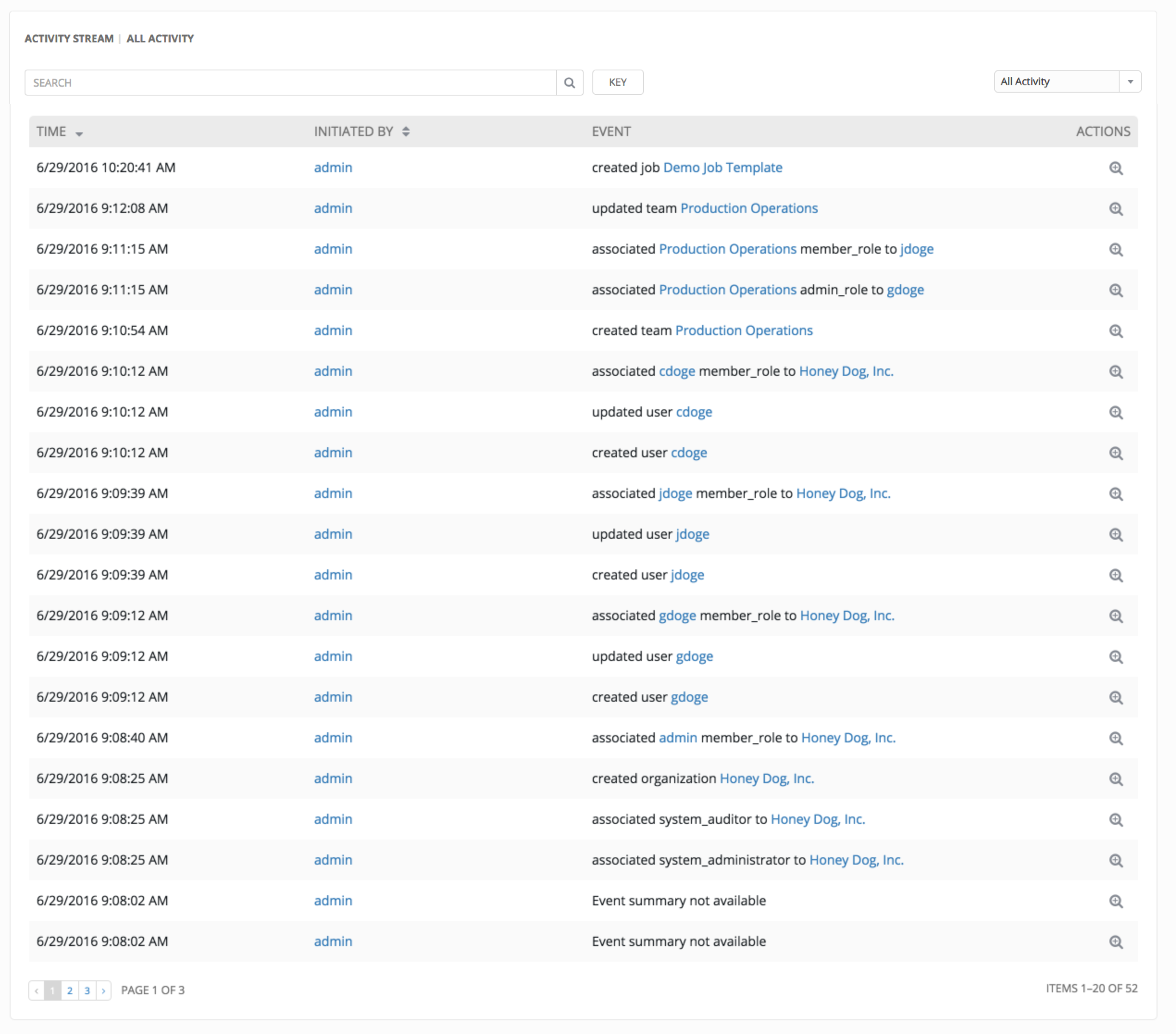
An Activity Stream shows all changes for a particular object. For each
change, the Activity Stream shows the time of the event, the user that
initiated the event, and the action. Clicking on the Examine ( ) button shows the
event log for the change.
) button shows the
event log for the change.
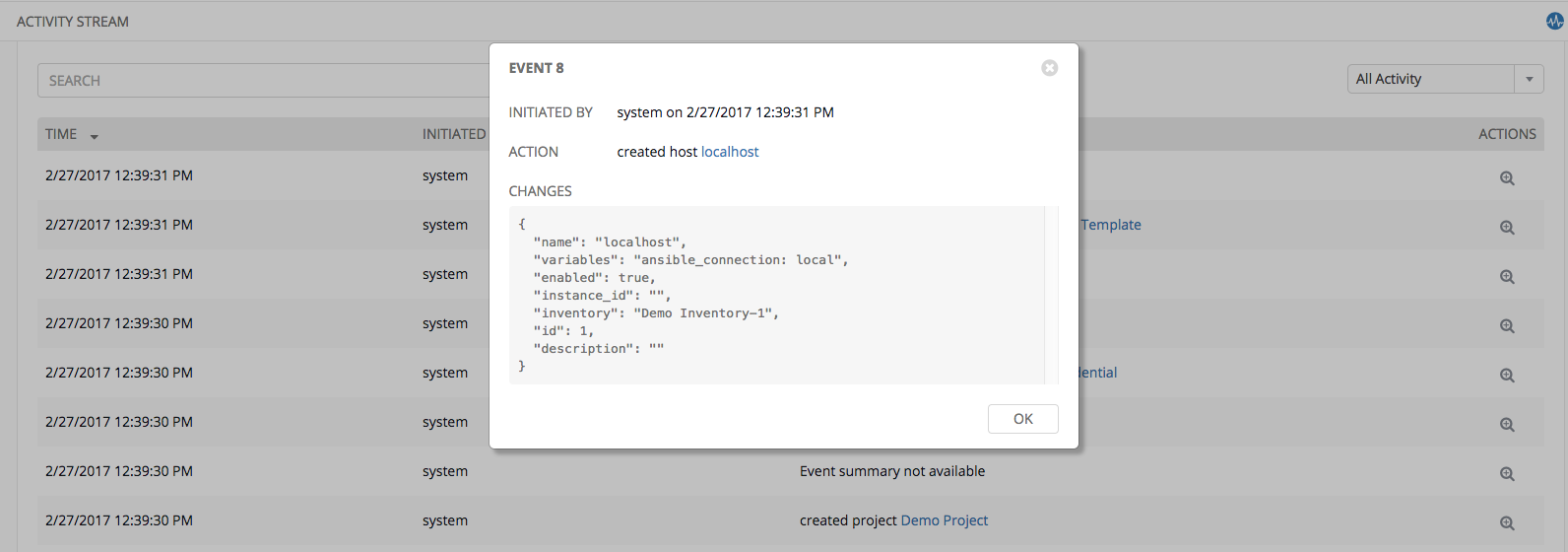
The Activity Stream can be filtered by the initiating user (or the system, if it was system initiated), and by any related Tower object, such as a particular credential, job template, or schedule.
The Activity Stream on the main Dashboard shows the Activity Stream for the entire Tower instance. Most pages in Tower allow viewing an activity stream filtered for that specific object.
5.2. Views¶
The Tower User Interface provides several options for viewing information.
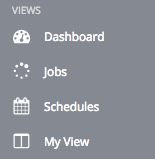
5.2.1. Dashboard view¶
The Dashboard view begins with a summary of your hosts, inventories, and projects. Each of these is linked to the corresponding objects in Tower for easy access.

On the main Tower Dashboard screen, a summary appears listing your current Job Status. Also available for review are summaries of Recently Used Templates and Recent Job Runs.
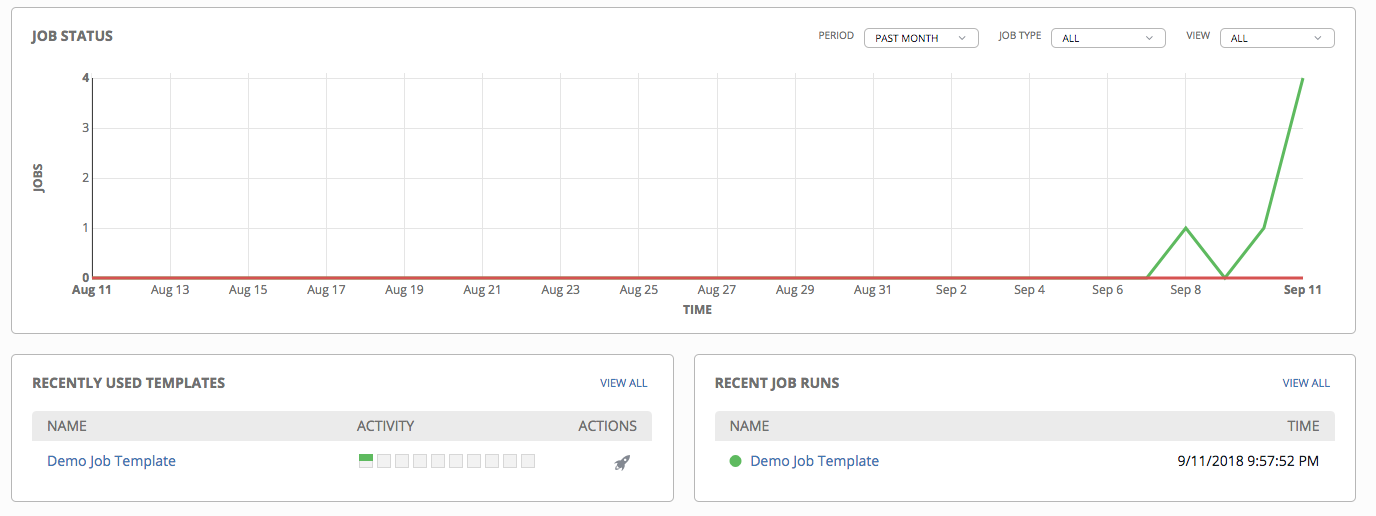
The Job Status graph displays the number of successful and failed jobs over a specified time period. You can choose to limit the job types that are viewed, and to change the time horizon of the graph.
The Recently Used Templates section of this display shows a summary of the most recently used templates. You can also access this summary by clicking the Templates (![]() ) icon from the left navigation bar.
) icon from the left navigation bar.
The Recent Job Runs section displays which jobs were most recently run, their status, and time when they were run as well.
Note
Clicking on the Dashboard ( ) icon from the left navigation bar or the Ansible Tower logo at any time returns you to the Dashboard.
) icon from the left navigation bar or the Ansible Tower logo at any time returns you to the Dashboard.
5.2.2. Jobs view¶
Access the Jobs view by clicking the Jobs (![]() ) icon from the left navigation bar. This view shows all the jobs that have ran in Tower, including projects, templates, management jobs, SCM updates, playbook runs, etc.
) icon from the left navigation bar. This view shows all the jobs that have ran in Tower, including projects, templates, management jobs, SCM updates, playbook runs, etc.
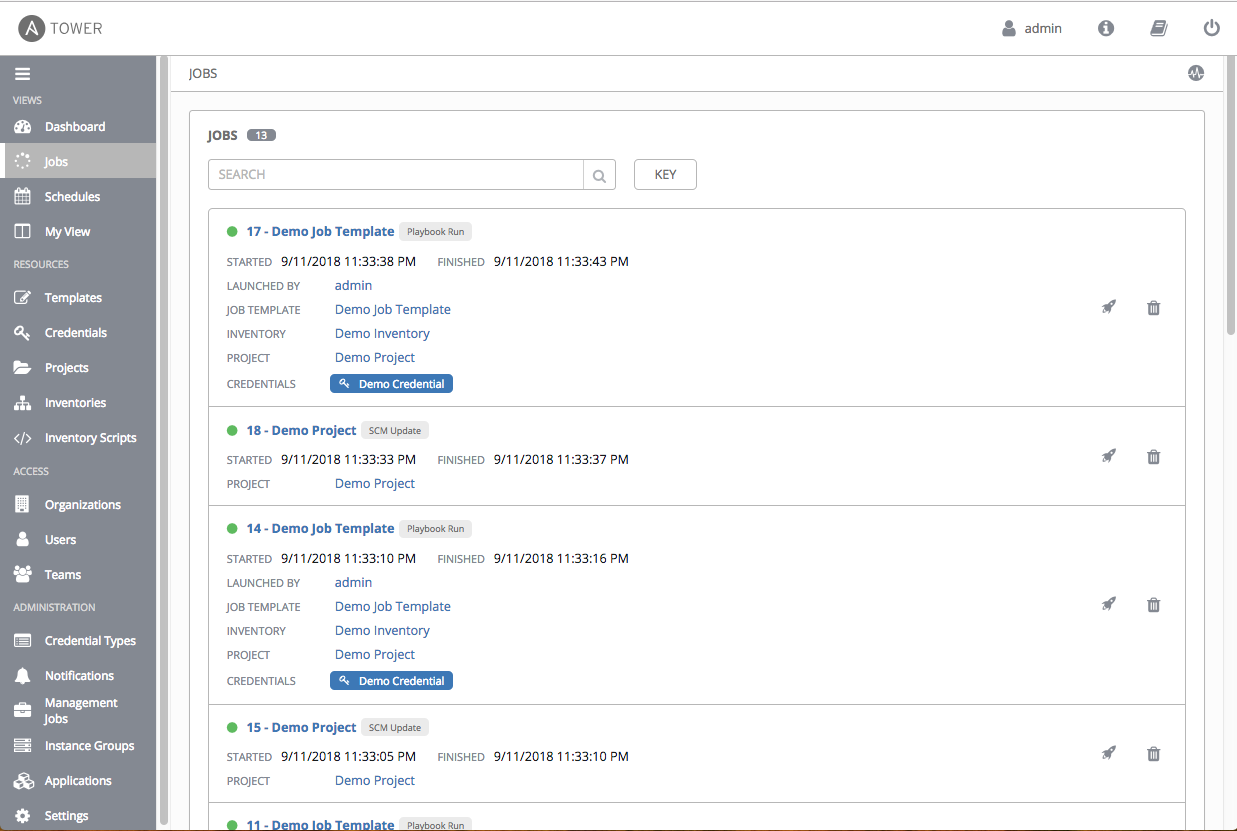
5.2.3. Schedules view¶
Access the Schedules view by clicking the Schedules (![]() ) icon from the left navigation bar. This view shows all the scheduled jobs that are configured.
) icon from the left navigation bar. This view shows all the scheduled jobs that are configured.

5.2.4. My View¶
My View, is a user’s single-page view of jobs and job templates. It can be accessed by clicking the My View (![]() ) icon from the left navigation bar or by navigating to
) icon from the left navigation bar or by navigating to https://<Tower server name>/portal.
My View is a simplified interface for users who need to run Ansible jobs, but that do not need an advanced knowledge of Ansible or Tower. My View could be used by, for instance, development teams, or even departmental users in non-technical fields.
My View offers Tower users a simplified, clean interface to the jobs that they are able to run, and the results of jobs that they have run in the past.
Pressing the  button beside a job in My View launches it, potentially asking some survey questions if the job is configured to do so.
button beside a job in My View launches it, potentially asking some survey questions if the job is configured to do so.

My View displays two main sections–Job Templates and Jobs. The Job Templates panel shows the job templates that are available to be run. To launch a job template, click the  button. This launches the job, which can be viewed in the Jobs panel.
button. This launches the job, which can be viewed in the Jobs panel.
The Jobs pane shows the list of jobs that have run in the past. Sort for jobs specific to you by clicking the My Jobs button or review all jobs you have access to view by clicking the All Jobs button, above the search bar.
My Jobs: View jobs that you (as the user) ran.
All Jobs: View your team members’ completed jobs, viewable based on your RBAC permissions.
For each job, you can view and sort by any number of the job’s attributes shown. Clicking on the link for the job opens a new window with the Job Details for that job (refer to Jobs for more information).
Other portions of the interface are hidden from view until My View is exited.
5.3. Resources and Access¶
The Resources and Access menus provide you access to the various components of Ansible Tower and allow you to configure who has permissions for which of those resources.
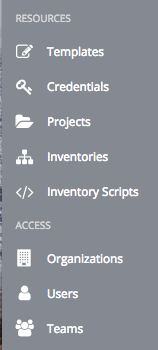

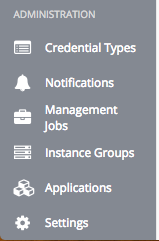
 ) menu offers access to administrative configuration options. Users of older versions of Ansible Tower (2.4.5 or older) can access most of these through the top-level navigational menu or from their “Setup” menu button.
) menu offers access to administrative configuration options. Users of older versions of Ansible Tower (2.4.5 or older) can access most of these through the top-level navigational menu or from their “Setup” menu button.